|
Less than 3% of Earth's water is freshwater, and 99% of that is trapped in ice or underground. The remaining 1% is found in freshwater biomes that provide us with over half of our drinking water. Due to varying water levels, climates, and diverse forms of life, each freshwater biome is unique. Approximately 35 species of freshwater plants reside in the the waters and wetlands of Pipestone National Monument, serving as both food and protection for a wide array of wildlife. Many of these species are at risk from the spread of non-native Reed Canary grass, which forms thick mats of vegetation in wet areas and quickly outcompetes and replaces native water plants. Learn more about a few of the Monument's freshwater plants below: 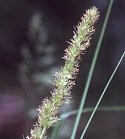
Robert H. Mohlenbrock. USDA SCS. 1989. Midwest wetland flora: Field office illustrated guide to plant species. Midwest National Technical Center, Lincoln. Courtesy of USDA NRCS Wetland Science Institute. Spikerush or Eleocharis obtusa Woolly sedge or Carex pellita Tussock sedge or Carex stricta Heavy sedge or Carex gravida Fox sedge or Carex vulpinoidea Limestone meadow sedge or Carex granularis "Sedges have edges, rushes are round, grasses have knees that bend to the ground!" The sedges at the Monument often resemble grass, but their stems are actually triangular. If you turn them in your fingertips, you can feel the edges. Another difference is hidden inside the stems. Grasses are hollow (except at the nodes), while sedges and rushes have a pithy center (but remember, the rush will be round, unlike the sedge). If you're still stumped, just look under the seed/flower. Sedges will have one bract (or scale) underneath it, grasses will have two, and rushes will hold six! The spikerush reaches 1.5 feet tall in height. It has grass-like leaves at its base and arching, erect, but weak stems which terminate in oblong spikes of roughly 10 flowers. Woolly sedge grows in a colony of individual stems one to three feet tall. The inflorescence is roughly one foot long and includes a cylindrical cluster of overlapping flowers. The fruit is covered in a fuzzy perigynium. Tussock sedge grows in dense clumps up to three feet high and two feet across. As the grass-like leaves die, they pile up under and on the plant, creating a 'tussock.' Many different birds and small mammals, such as squirrels, feed on the seeds that the wind disperses. Growing up to three feet tall, the heavy sedge has 3-5 leaves on the lower third of each stem. The stems terminate in a compact inflorescence 2 inches long with 5-15 chunky spikes crowded at the top. Songbirds, Prairie Chickens, Ring-Neck Pheasants, Wild Turkeys, and a multitude of insects use this sedge for food. The fox sedge resembles grass and grows in clumps that spray out like a fountain three feet high and two feet across. The stems terminate in a tight clump of overlapping spikelets. The bristly appearance of these seedheads create the illusion of a fox's tail. Insects such as grasshoppers and a variety of wetland birds use this sedge for food. Limestone meadow sedge can grow up to two feet tall. The stems have 5 alternating, distinct blue-green leaves and 1-2 axillary pistillate (female) spikes, 1-2 terminal pistillate spikes, and a single terminal staminate (male) spike, sometimes crowded by the cluster of pistillate spikes beneath it. The pistillate spikes are cylindrical and grainy. Although not preferred by deer or rabbits, it is used for food by caterpillars, grasshoppers, waterfowl, and songbirds. 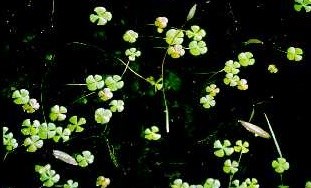
Gary Larson, hosted by the USDA-NRCS PLANTS Database / USDA NRCS. 1992. Western wetland flora: Field office guide to plant species. West Region, Sacramento. Hairy pepperwort or Marsilea vestita The Marsilea genus is named for the Italian naturalist, scholar, soldier, and emissary, Luigi Ferdinando Marsili. This species strongly resembles a four-leaf clover, but is actually an aquatic fern. The stems can grow up to 8 inches long and the leaves can appear either above water or submerged. They live along the edges of ponds and areas with fluctuating water levels. Marsilea vestita is currently endangered in the state of Minnesota. 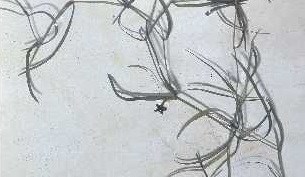
Robert H. Mohlenbrock, hosted by the USDA-NRCS PLANTS Database / USDA NRCS. 1995. Northeast wetland flora: Field office guide to plant species. Northeast National Technical Center, Chester. Leafy Pondweed or Potamogeton foliosus This perennial herb grows up to 30 inches long with thin, multi-branches stems. The leaves are also thin, approximately 4 inches long, grass-like, and tapering. This plant is eaten by fish, turtles, and birds. Leafy pondweed often grows in dense mats, providing cover and protection for smaller fish and aquatic life. 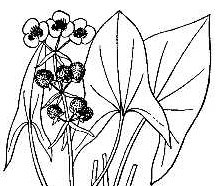
USDA-NRCS PLANTS Database / Britton, N.L., and A. Brown. 1913. An illustrated flora of the northern United States, Canada and the British Possessions. 3 vols. Charles Scribner's Sons, New York. Vol. 1: 99. Arum-leaved arrowhead or Sagittaria cuneata This member of the water plantain family can grow up to 2 feet tall. It can be identified by the distinctive arrowhead-shaped leaves that point upward and are 3-3.5 inches long and 2 inches wide. The flowers are whorled in groups of three with three white petals. Female flowers have a bulbous green center while male flowers sport yellow stamens. Honeybees, bumblebees, and butterflies are attracted to the flowers while ducks, geese, and muskrats feed on its stalks and tubers. 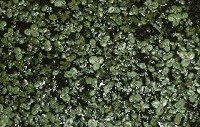
Robert H. Mohlenbrock, hosted by the USDA-NRCS PLANTS Database / USDA NRCS. 1995. Northeast wetland flora: Field office guide to plant species. Northeast National Technical Center, Chester. Common duckweed or Lemna minor The leaves of common duckweed float on or just beneath the surface of water. Each stem may have one to four small, oval-shaped leaves. Because they are among the smallest of flowering plants, they can often appear as algae. Evidence suggests that duckweed is effective in bioremediation (water purification) by removing heavy metals from water sources. Other uses include high-protein food for livestock, watewater nutrient recovery, and biofuel. 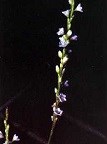
Robert H. Mohlenbrock, hosted by the USDA-NRCS PLANTS Database / USDA NRCS. 1992. Western wetland flora: Field office guide to plant species. West Region, Sacramento Water pepper or Polygonum hydropiper (exotic species) Dotted smartweed or Polygonum punctatum Dotted smartweed reaches upwards of 2.5 feet tall with alternating, thin, lance-shaped leaves. Small, white-greenish flowers are spaced out along thin, arching racemes towards the ends of the upper stems. Bees, butterfly larvae, ducks, and songbirds use this plant for food, as do white-tailed deer, muskrats, and snapping turtles to a lesser extent. Water pepper is present in the Monument's prairie, but is not native. Both plants are similar in appearance, but dotted smartweed's racemes of flowers are more erect than water pepper's. 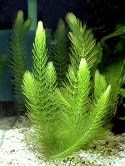
Public Domain, Totodilefan via Wikimedia Commons Coontail or Ceratophyllum demersum The rootless coontail grows underwater from three to ten feet tall. The upward-curling side shoots with their spiny leaves give this plant a bushy appearance like a Christmas tree or raccoon's tail. Although waterfowl do eat this plant, it's more vital as a source of protection and cover for young fish. Coontail's are commonly used in aquariums. 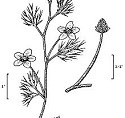
USDA-NRCS PLANTS Database / USDA NRCS. Wetland flora: Field office illustrated guide to plant species. USDA Natural Resources Conservation Service. Yellow water buttercup or Ranunculus flabellaris Water crowfoot or Ranunculus longirostris Cursed crowfoot or Ranunculus scleratus The Ranunculus genera of the buttercup/crowfoot family contains over 600 species. The term crowfoot comes from the leaves of these plants resembling a crow's foot. The flowers are small, often with shiny petals. The yellow water buttercup often has upwards of eight yellow petals while the cursed crowfoot has five, both with green, ovoid centers. The longbeak crowfoot stands out from these two with five white petals and yellow stamens. However, like all Ranunculaceae, these three plants contain the toxin protoanemonin, which is harmful to both humans and animals. 
Public Domain, Wikimedia Commons Fernald's yellowcress or Rorippa palustris Small, spoon-shaped yellow flowers cluster at the ends of this plant's stems with 3-7 oblong, large lobes forming its leaves. The straight stems can grow as tall as 3 feet, and it's widespread throughout North America, preferring damp, wet habitats. Flies, bees, and other insects are attracted to its flowers, but it does not seem to appeal to mammalian herbivores. 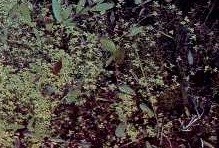
Gary Larson, hosted by the USDA-NRCS PLANTS Database / USDA NRCS. 1992. Western wetland flora: Field office guide to plant species. West Region, Sacramento. Vernal water starwort or Callitriche palustris The vernal water starwort grows between 2-8 inches long submerged in water, but sometimes floating near the surface as well. The small, simple, spatulate leaves are less than a quarter-inch long. Like many freshwater plants, it provides food for waterfowl and protection for small fish. The tiny, imperfect flowers can be pollinated by wind when above the water's surface and by water when submerged. 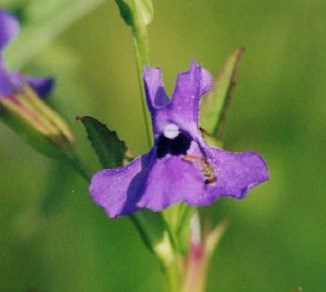
USDA NRCS PLANTS Database Clammy hedgehyssop or Gratiola neglecta Allegheny monkey flower or Mimulus ringens These plants belong to the figwort family. The hedgehyssop grows to roughly one foot tall with lance-shaped, alternating leaves. The tubular flowers are 1/3 of an inch long with four to five white petals and five narrow sepals at their base. The taller (one to three feet) monkey flower has distinct flowers resembling a snapdragon, with purple two-lipped corollas. |
Last updated: May 27, 2020
